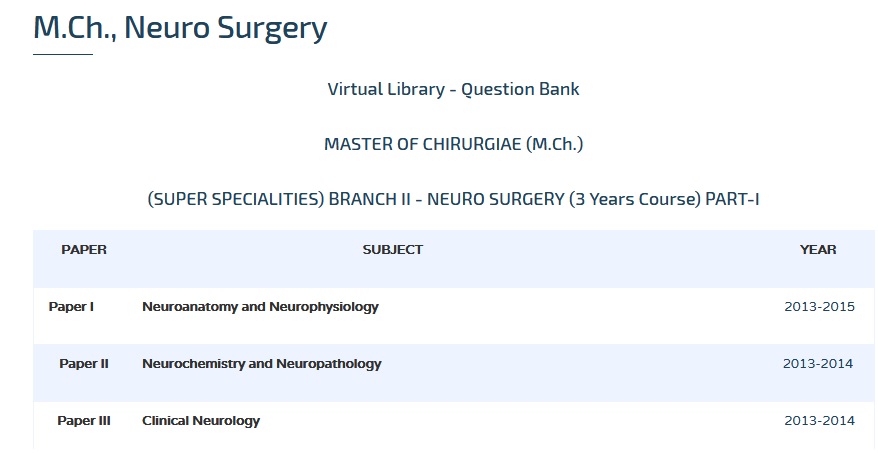Clinical Neurology M.Ch Question Bank : web.tnmgrmu.ac.in
Name of the University : The Tamilnadu Dr. M.G.R. Medical University
Degree : MASTER OF CHIRURGIAE (M.Ch.)
Branch : BRANCH II – NEURO SURGERY
Subject Code/Name : 1563/CLINICAL NEUROLOGY
Paper : III
Document Type : Question Bank
Website : web.tnmgrmu.ac.in
Download Model/Sample Question Paper :
(3 Years Course) PART-I :
2013-2014 : https://www.pdfquestion.in/uploads/web.tnmgrmu.ac.in/4538-1-181563LC.pdf
(5 Years Course) PART-II :
1990-2000 : https://www.pdfquestion.in/uploads/web.tnmgrmu.ac.in/4538-2-181563KC.pdf
2001-2014 : https://www.pdfquestion.in/uploads/web.tnmgrmu.ac.in/4538-3-181563KU.pdf
TNMGRMU Clinical Neurology Question Paper
Sub.Code:1563
M.Ch-NEUROSURGERY
THREE YEARS COURSE – PART –I
Paper – III CLINICAL NEUROLOGY
Q.P. Code:181563
Time: 3 hours Maximum :100 marks
(180 Min)
Related : TNMGR Clinical Neurology & Neuro Radiology M.Ch Question Bank : www.pdfquestion.in/4542.html
February 2013
I.Elaborate on: (2x15marks=30marks)
1. The Clinical approach and Investigations for a patient with symptoms of bladder dysfunction.
2. The Clinical approach and Investigation in an adult patient with a spontaneous intracranial haemorrhage.

II. Write notes on: (10x7marks=70marks)
1. Critical illness Polyneuropathy
2. Hypokalemic Periodic Paralysis
3. Myasthenia Gravis
4. Becker- Type Muscular dystrophy
5.Muscle Tone
6. Hemifacial Spasm
7.Trigeminal Neuralgia
8. Carpal Tunnel Syndrome
9. Diabetic Neuropathy
10. Syringomyelia
August 2013
I. Elaborate on: (2X15=30)
1. Discuss the causes and management of a young adult presenting with recurrent episodes of pyogenic meningitis.
2. Enumerate the clinical features, differential diagnosis of a patient presenting with acute onset ascending flaccid weakness of all four limbs and outline the relevant investigations that would confirm the diagnosis.
II. Write notes on: (10X7=70)
1. Status epilepticus.
2. Corneal reflex.
3. Frontal lobe release signs.
4. Idiopathic intracranial hypertension.
5. Moyamoya disease.
6. Apraxia.
7. Cruciate hemiparesis.
8. Weber’s syndrome.
9. Putamenal hemorrhage.
10. Carpal tunnel syndrome.
February 2014
I. Elaborate on: (2X15=30)
1. Discuss the anatomical diagnosis in a thirty year old male presenting with progressive paraparesis of two months duration. Outline the management of this patient towards arriving at the diagnosis.
2. Enumerate the symptoms of raised intracranial pressure. Discuss the pathophysiological basis for the same.
II. Write notes on: (10X7=70)
1. Myasthenia gravis.
2. Compare and contrast clinical findings in lesions of the motor root Vs anterior horn cell.
3. Amyotrophic lateral sclerosis.
4. Postural hypotension.
5. Unilateral dilated pupil.
6. Normal pressure hydrocephalus.
7. Ataxia.
8. Complex partial seizures.
9. Spinal shock.
10. Gerstmann’s syndrome.
August 2014
I. Elaborate on: (2 x 15 = 30)
1. Discuss the causes, pathophysiology and management of a young lady with idiopathic intracranial hypertension.
2. Discuss the causes, pathophysiology and management of a patient with Guillain Barre Syndrome.
II. Write notes on: (10 x 7 = 70)
1. Moya moya disease.
2. Immunoglobulin therapy in neurology.
3. Cerebral venous thrombosis.
4. Cruciate hemiplegia.
5. Management of migraine.
6. False localizing signs in neurology.
7. Spino cerebellar ataxia.
8. Frontal lobe release signs.
9. Top of basilar artery occlusion.
10. Diabetic neuropathy.
August 2009
I. Essays: (2 x 20 = 40)
1. Describe the risk factors, clinical features, investigations and treatment of ischemic strokes.
2. Describe the clinical features and treatment of Parkinsonism.
II. Write short notes on: (10 x 6 = 60)
1. Duchene muscular dystrophy.
2. Gullian Barre syndrome.
3. Essential tremor.
4. Pontine hemorrhage.
5. Optic neuritis.
6. TB Meningitis.
7. Treatment of Neurocysticercosis.
8. Creutzfeldt Jacob disease.
9. Motor Neuron disease.
10. Migraine.
August 2011
I. Elaborate on :
1. Discuss the treatable causes of dementia and their differential diagnosis.
2. Discuss the diagnosis and management of multiple sclerosis.
II. Write notes on :
1. Non compressive myelopathy.
2. Posterior reversible leucoencephalopathy.
3. Neuro-ophthalmic manifestations of occipital lobe lesions.
4. Release reflexes.
5. Transcortical aphasias.
6. Huntington’s disease.
7. Bromocriptine.
8. Migraine prophylaxis.
9. Benign rolandic epilepsy.
10. Medical treatment of spasticity.
August 2012
Sub. Code: 1563
Answer ALL questions in the same order.
I. Elaborate on: Pages Time Marks (Max.)(Max.)(Max.)
1. Cerebral palsy and management. 16 35 15
2. Discuss language and speech disorders and its evaluation. 16 35 15
II. Write notes on:
1. Complex Partial Seizure. 4 10 7
2. Frontal lobe release syndrome. 4 10 7
3. Dementia – Classification and Evaluation. 4 10 7
4. Syncope. 4 10 7
5. Vertigo – Classification and Evaluation. 4 10 7
6. SAH – Classification and Evaluation. 4 10 7
7. Multiple Sclerosis. 4 10 7
8. Post Traumatic Amnesia and its importance. 4 10 7
9. Cushing response. 4 10 7
10. Pseudopapilloedema. 4 10 7
February 2013
Sub.Code:1563
I.Elaborate on: (2x15marks=30marks)
1. The Clinical approach and Investigations for a patient with symptoms of bladder dysfunction.
2. The Clinical approach and Investigation in an adult patient with a spontaneous intracranial haemorrhage.
II. Write notes on: (10x7marks=70marks)
1. Critical illness Polyneuropathy
2. Hypokalemic Periodic Paralysis
3. Myasthenia Gravis
4. Becker- Type Muscular dystrophy
5. Muscle Tone
6. Hemifacial Spasm
7. Trigeminal Neuralgia
8. Carpal Tunnel Syndrome
9. Diabetic Neuropathy
10. Syringomyelia